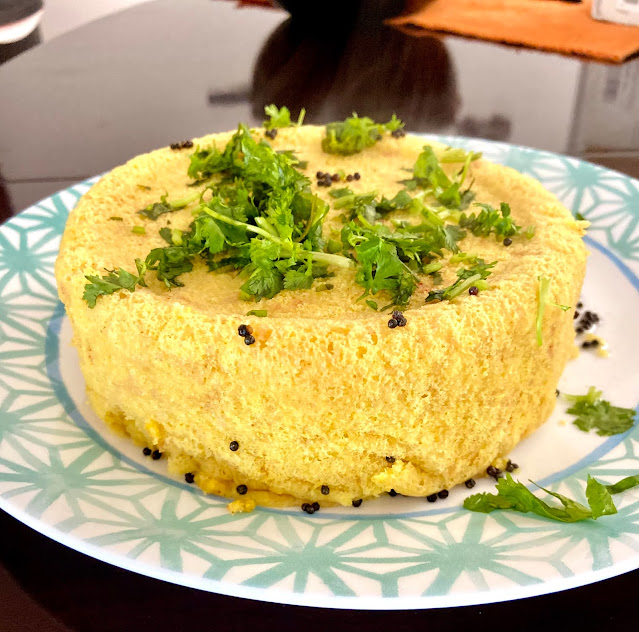Dhokla Experiments and Such
It is a sad truth that the world is yet to recognize the beauty of regional Indian cuisine. This is agonizing for someone like me who craves Malayali food, mithai, and Delhi classics like chhole bhature, rarely served at Indian restaurants, at an unusual frequency. When I need my appam and fish molee breakfast fix, for instance, I must venture into the kitchen, mentally prepared for the suspense inherent in fermentation, knowing that it will be a good 18-24 hours before I get to dig in. I must soak rice for a few hours, grind it with coconut milk, and leave the batter to ferment overnight, to be able to sit down for an appam breakfast the next day. When I wake up in the morning, I head to the kitchen, still groggy, to check on the health of my batter before I proceed to make breakfast, one appam at a time. By the end of it all, I am left wondering if I should have just settled for toast. This is not to say that appam making is never fun. It's just that I have to put in quite a bit of elbow grease to earn my appams whenever the craving strikes, because San Francisco doesn't have a single Malayali restaurant.
Sure, a lot has changed since I moved abroad several years ago. Take ghee, for instance. A while ago (before a virus took the world hostage), I was at my neighborhood Safeway, scanning the rows of spices in the Asian section in search of Thai red curry paste. There, on the shelf, was a jar of “ghee butter”. On the label was a cow, placidly chewing at a patch of grass. I chuckled. Ghee being the Indian word for clarified butter, “ghee butter” translates to “butter butter”, which sounds like baby talk. Until then, I’d rarely seen ghee in mainstream American supermarkets. A few weeks later, I was waiting in a typically long line in a hipster San Francisco cafe, admiring the cracked domes of overpriced sourdough loaves perched on wooden shelves. On the menu was $8 avocado toast, a large variety of kombucha, and other such San Francisco staples. Here, in the last place I would have expected it, were more jars of ghee, right beside the loaves. I looked online to see if I was reading too much into this double sighting. Ghee butter popped up everywhere I looked. Amazon sells several brands of ghee butter (and butter ghee, too, by the way). You can even buy flavored ghee. Himalayan pink salt ghee and Madagascar vanilla ghee are only two of the intriguing options I came across. And it's not just San Franciscans who are enamored by ghee. Americans everywhere seem to be buying it. Jo Mo from Florida is a fan as is Mom4kids from Texas. I had to agree with astute D.M., who tempered his approval with a good dose of pragmatism - “at $20/lb., my ghee better be infused with unicorn blood.”
Just like ghee, haldi doodh has also caught on in the U.S. Yes, that medicine foisted on resistant Indian children with the promise that it will quell a cold or soothe a sore throat, hardly the beverage of choice in India. Certainly, if you tried selling turmeric milk in India, you’d get laughs, not rupees. It’s a different story here in the U.S. “Golden milk” has had its day in the venerable New York Times. It’s had its praises sung by Zagat. It’s also been presented in an entirely different avatar - on the rocks - in a popular American food magazine. This spin on haldi doodh troubles me. It is as if a fundamental truth of my childhood is being tinkered with.
I have to confess that in all these years, I haven't done enough experimenting with regional Indian recipes in my kitchen. I'm slowly dipping my toes into that ocean. A few months ago, I tried my hand at making dhokla. I ended up with a disastrous brick that went straight into the compost bin (an unparalleled tragedy in my kitchen). But hope springs eternal. So I did some research and found that many recipes call for Eno fruit salt. In my mind, the association between Eno and food has always been negative. Eno is marketed as an antacid in India. A range of Eno ads from the mid-1990s sprang to mind, and I found them all on good ole Youtube. The ads feature a range of men and women - a job aspirant anxiously waiting his turn to be interviewed, a mother stressed out about baking a birthday cake for her daughter, a dad who'd just toured an exhausting number of schools for his son. Each of them spoke to the camera, expressing the uncomfortable digestive predicament they'd been in because of acidity until bubbly Eno rescued them and saved the day. I would've never guessed that Eno might serve as a secret ingredient in a dhokla recipe. But it makes sense. Eno provides the lift that makes for spongy dhoklas. So I bought some Eno from the Indian store, and tried again. This time, the dhokla was perfect. I proceeded to make it a couple more times in quick succession because it really is quite easy to put together, once you get the hang of it. So for a change, I have a picture of a savory "cake" that I made not in the oven, but in a steamer. I used this recipe from a wonderful, trusty Indian blog, Veg Recipes of India. Here's to more exploring!



Comments
Post a Comment